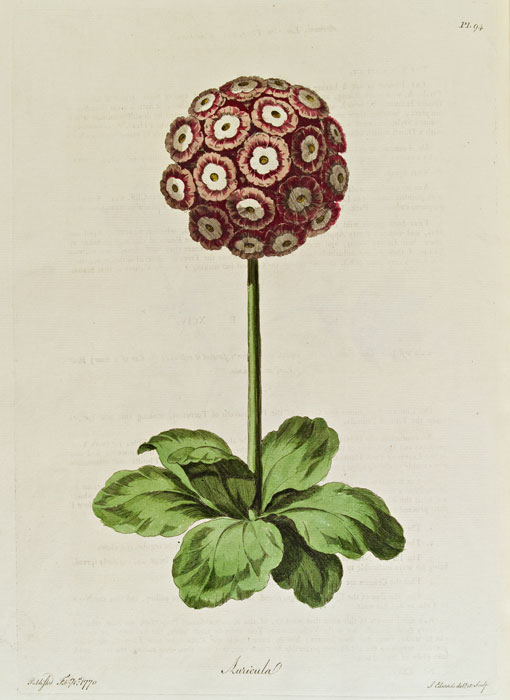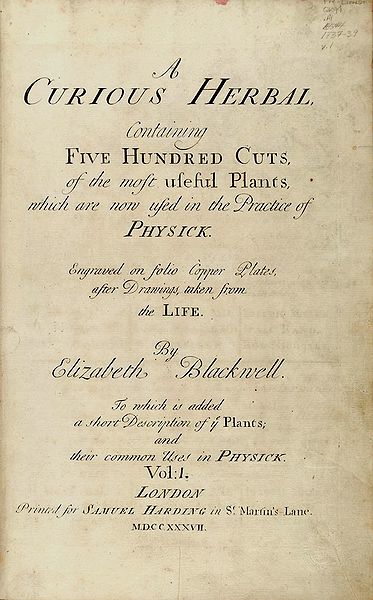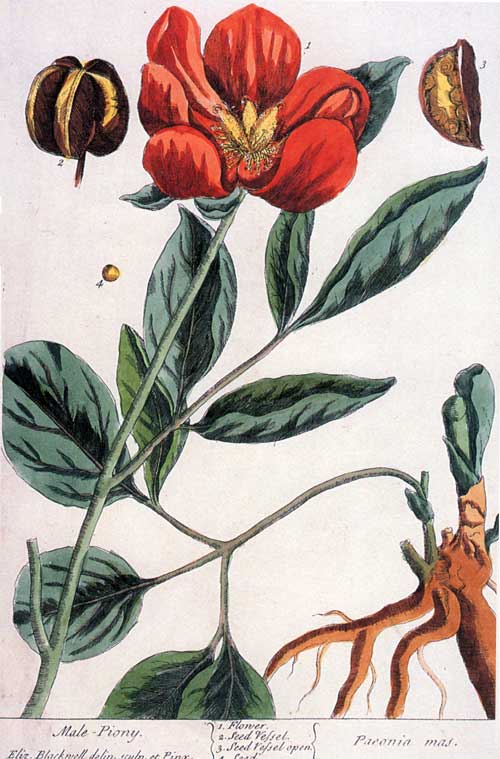Well now that Spring finally feels like it has arrived, one’s thoughts head into dirt and gardens and plants and herbs, so wanted to share this article from the most recent issue of Colonial Williamsburg: “Uncommon and Expensive” by Mary Miley Theobald, on John Edwards’s The British Herbal – you can read it online here:
There may be no better guide to the plants that grew in eighteenth-century gardens than The British Herbal, a rare collection of botanicals by artist John Edwards, published in 1770. “It’s one of the most valuable books we have,” said Wesley Greene, garden historian in Colonial Williamsburg’s historic trades department. “It lets us document the sort of plants that were available in the colonial era.” Edwards referenced Linnaeus for every plant, allowing Greene and others to identify species precisely.
Edwards, John. The British Herbal, containing one hundred plates of the most beautiful and scarce flowers and useful Medicinal Plants which blow in the open air of Great Britain, accurately coloured from nature with their Botanical Characters, and a short account of their cultivation. London: Printed for the Author; and sold by J. Edmonson…and J. Walter, 1770.
You can see this slideshow of a number of the prints here: http://history.org/foundation/journal/Spring13/herbals_slideshow/#images/herbals4.jpg
[images from the Colonial Williamsburg article, photography by Barbara Lombardi]
The book is indeed quite rare: a quick look at auction records shows that one sold for $17,026 in 1993; for $25,300 in 1997 and for $36,000 in 2000.
One wonders if Jane Austen knew this work – there is no mention of it in her letters or novels, nor is it in Gilson’s bibliography as a work known to have been owned by her.
She may have been more familiar [as I was] with Elizabeth Blackwell’s A Curious Herbal (London, 1739) – you can view this whole work online at the British Library at their “Turning Pages” site: http://www.bl.uk/onlinegallery/ttp/blackwells/accessible/introduction.html#content
Blackwell’s illustrations are quite lovely as this one example of a male peony shows:
[image from Picturing Plants]
The story of Elizabeth Blackwell’s (1707-1758) creation and publication of this work is an interesting tale – she drew, engraved and colored all the illustrations to accompany the botanical descriptions of her doctor husband in order to pay his debts and effect his release from prison. Many of the plant specimens were from the Chelsea Physic Garden in London. A copy sold at Christies in 2009 for $17,500, and various plates appear at auction periodically.
We do know that Jane Austen knew of Gilbert White, author of The Natural History of Selborne (1789), and whose house, now a museum, was near the Austen’s home in Chawton. The herb garden at White’s house is depicted in Kim Wilson’s In the Garden with Jane Austen [page 98] with a list of the herbs, and you can visit the house and garden site here.
So now into the garden and away from the computer … but will ask, What is your favorite herbal book?





Deb, there must be something in the air; sap rising, the fertility of the soil or something. I have just written about a garden, plants and seeds and various great 18th century botanists on both sides of the Atlantic too.
Love the fantastic illustrations.
If ever you got to Kew, and you must one day,. I’ll even take you, they have a museum of the history of botany and exhibits including botanical samples and many fantastic illustrations going back to the 18th century.
All the best,
Tony
LikeLike
Hi Tony – how funny is that – I just see your post on plants, etc – excellent! I just did this quick post because the article in Colonial Williamsburg was so interesting and I wanted to just mention Blackwell’s herbal – I have missed getting to Kew several times – but do have a lovely book on it… I will hold you to that tour when next I am over there!
Thanks as always for stopping by,
Deb
LikeLike
Lovely and timely article to read and look at. The illustration of that Auricula is incredible, the flower almost looks like it could be a photograph. The slide show was fun. Thanks!
Also appreciate Tony Grant’s post re Kew Gardens. I was there once but hadn’t enough time to see it all — I’d say a return trip is definitely on my list now for a visit to the museum. (I’m no gardener, only knew the Auricula from the label under the picture, LOL… but I’m interested!)
I have a copy (modern reprint) of Culpeper’s Herbal, which predates those cited here. But I don’t know that it is my ‘favorite’ – just the only one with which I have been acquainted to date.
LikeLike
Hello Tess! – yes, the Culpeper’s Herbal is a great book! – I should do a more complete post on all the herbals out there! now off to read Tony’s post – guess we are all thinking Spring!
LikeLike
A link to Museum No1 at Kew.
http://www.kew.org/heritage/places/museum1.html
All the best, Tony
LikeLike
Just realised . You mention Gilbert white. The time before last when I had Clive staying with us we set ourselves the task of reading Gilbert Whites, Natural History of Selborne, which we both did before Clive arrived from Canada. and, yes, you guessed, we spent a day at Selborne exploring Whites walks and landscape and observing White’s beloved, “Hirondells,” swooping about and slicing the air above the wooded hangar above Selborne. His museum is brilliant. You can find the small headstone with just his intitials G.W. carved into it behind the beautiful country church in Selborne where I am sure he often took the service.
I have loads and loads of photographs, Deb.
You really must come and spend a few months living here to see all the places you SHOULD see, Deb!!!!!!!!!!
Marilyn and I will put you up. Come next year. We having a lot done to the house later this year so we will be a building site for a while. When it’s done you must come and stay.
LikeLike
Reblogged this on Mary Beth Bass and commented:
I love this post!
LikeLike
Thank you Mary Bess – I appreciate that!
LikeLike